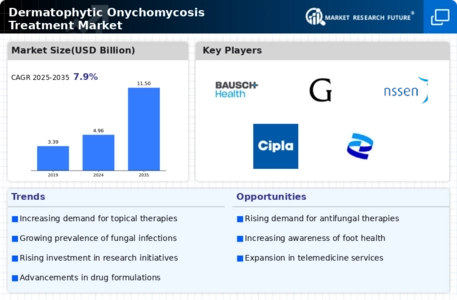Market Share
Dermatophytic Onychomycosis Treatment Market Share Analysis
In the highly competitive landscape of the Dermatophytic Onychomycosis Treatment Market, companies employ various market share positioning strategies to gain a competitive edge and maximize their presence in the industry. One prevalent approach is differentiation, where companies focus on offering unique features or benefits that set their products apart from competitors. This could include innovative formulations, enhanced efficacy, or improved convenience of use. By differentiating their offerings, companies aim to attract consumers seeking specific solutions tailored to their needs, thereby carving out a distinct market share.
Another key strategy is pricing positioning, where companies strategically set their product prices relative to competitors. Some may opt for premium pricing, positioning their treatments as high-end products associated with superior quality or effectiveness. Conversely, others may adopt a cost leadership approach, offering more affordable options to appeal to price-sensitive consumers. By carefully analyzing market dynamics and consumer preferences, companies can determine the most effective pricing strategy to capture market share while maximizing profitability.
Moreover, market segmentation plays a crucial role in positioning strategies within the Dermatophytic Onychomycosis Treatment Market. By identifying distinct consumer segments based on factors such as demographics, psychographics, and treatment preferences, companies can tailor their marketing efforts and product offerings to better address the unique needs of each segment. For example, some segments may prioritize convenience and ease of use, while others may prioritize treatment efficacy or safety. By segmenting the market and targeting specific customer groups, companies can effectively allocate resources and optimize their market share positioning efforts.
In addition to differentiation, pricing, and segmentation, partnerships and collaborations also represent important strategies for market share positioning in the Dermatophytic Onychomycosis Treatment Market. By forging strategic alliances with healthcare providers, pharmacies, and other stakeholders, companies can expand their distribution networks and gain access to new customer segments. Collaborations with key opinion leaders and medical professionals can also help build credibility and trust in the market, enhancing brand reputation and driving patient adoption.
Furthermore, continuous research and development efforts are essential for maintaining a competitive position in the Dermatophytic Onychomycosis Treatment Market. Companies must invest in innovation to develop novel formulations, delivery systems, and treatment modalities that address unmet needs and offer superior clinical outcomes. By staying ahead of emerging trends and technological advancements, companies can strengthen their market position and differentiate themselves from competitors.
Lastly, effective marketing and promotional strategies play a crucial role in driving consumer awareness and preference for dermatophytic onychomycosis treatments. Through targeted advertising campaigns, educational initiatives, and physician outreach programs, companies can raise awareness about the condition and the importance of seeking treatment. By providing educational materials, patient support resources, and promotional offers, companies can engage consumers and healthcare professionals, driving demand and ultimately capturing market share.


 Source: Secondary Research, Primary Research, Market Research Future Database and Analyst Review
Source: Secondary Research, Primary Research, Market Research Future Database and Analyst Review





Leave a Comment